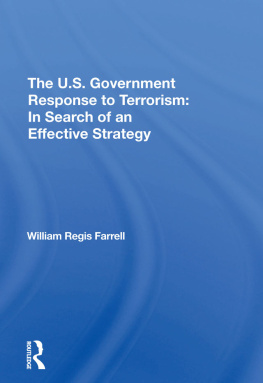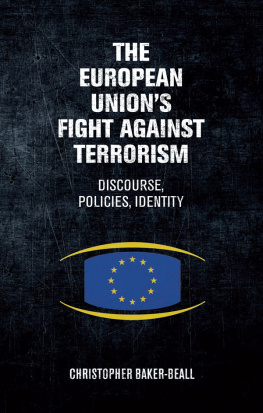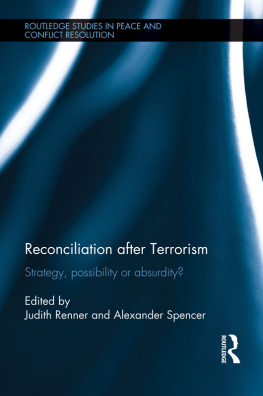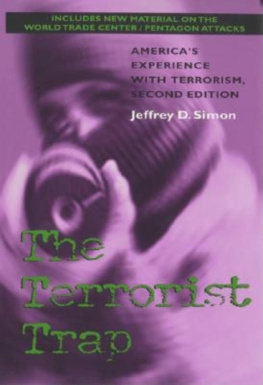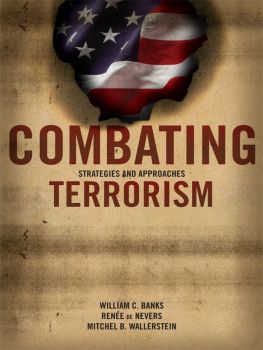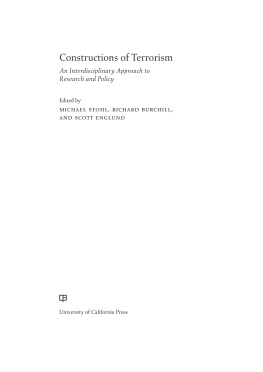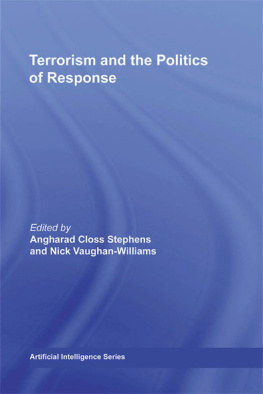The U.S. Government Response to Terrorism
Also of Interest
Victims of Terrorism, edited by Frank M. Ochberg and David A. Soskis
International Terrorism: An Annotated Bibliography and Research Guide, Augustus R. Norton and Martin H. Greenberg
* Terrorism and Hostage Negotiations, Abraham H. Miller
* Terrorism: Theory and Practice, edited by Yonah Alexander, David Carlton, and Paul Wilkinson
Self-Determination: National, Regional, and Global Dimensions, edited by Yonah Alexander and Robert A. Friedlander
Insurgency in the Modern World, edited by Bard E. O'Neill, William R. Heaton, and Donald J. Alberts
Global Human Rights: Public Policies, Comparative Measures, and NGO Strategies, edited by Ved P. Nanda, Jeunes R. Scarritt, and George W. Shepherd, Jr.
* Contemporary International Law: A Conoise Introduction, Werner Levi
Arms Transfers to the Third World: The Military Buildup in Less Industrial Countries , edited by Uri Ra'anan, Robert L. Pfaltzgraff, Jr., and Geoffrey Kemp
Terrorism and Global Security: The Nuclear Threat, Louis Rene Beres
Arms Transfers, Economic Growth, and Political Stability in Africa: The Risks of Military Development, Bruce E. Arlinghaus
* The United Nations and a Just World Order, edited by Richard Falk, Samuel Kim, Donald McNemar, and Saul Mendlovitz
National Security Crisis Forecasting and Management From Basic Research to Operational Use, edited by Gerald W. Hopple, Stephen J. Andriole, and Amos Freedy
*Available in hardcover and paperback.
Westview Special Studies in National and International Terrorism
The U.S. Government Response to Terrorism: In Search of an Effective Strategy
William Regis Farrell
This book examines the organizational problems faced by the U.S. government in developing an effective strategy to counter terrorism and presents a detailed history of U.S. counter-terrorist policy since 1972.
Dr. Farrell offers a working definition of terrorism, reviews its international, transnational, nonterritorial, and domestic forms, then focuses on the activities of those U.S. government agencies directly concerned with the prevention or neutralization of terrorism Critical of existing programs and of the fact that counter-terrorist activities seem to have a low priority among the duties of the relevant agencies' key executives, he concludes that the development of a clear, reasonable, and effective strategy against terrorism has been unnecessarily delayed. He is doubtful whether, even now, a satisfactory arrangement has been achieved.
Beyond looking strictly at governmental agency responses to terrorism, Dr. Farrell considers the sociological, legal, and operational factors that would be brought into play should military forces be employed to quell a terrorist attack and also addresses the nature and extent of the terrorist threat to U.S. businesses.
Dr. Farrell (Lt.Col., USAF) has been involved in counter-intelligence since 1966 and has conducted research at the U.S. Naval War College on the U.S. government's efforts to combat terrorism. He is now deputy chief, Security Division, Organization of Joint Chiefs of Staff, Washington, D.C.
For Marabeth, Kirsten, and Brendan With Love and Grateful Appreciation
The U.S. Government Response to Terrorism: In Search of an Effective Strategy
William Regis Farrell
First published 1982 by Westview Press, Inc.
Published 2019 by Routeldge
52 Vanderbilt Avenue, New York, NY 10017
2 Park Square, Milton Park, Abingdon, Oxon OX14 4RN
Routledge is an imprint of the Taylor & Francis Group, an informa business
Copyright 1982 Taylor & Francis
All rights reserved. No part of this book may be reprinted or reproduced or utilised in any form or by any electronic, mechanical, or other means, now known or hereafter invented, including photocopying and recording, or in any information storage or retrieval system, without permission in writing from the publishers.
Notice:
Product or corporate names may be trademarks or registered trademarks, and are used only for identification and explanation without intent to infringe.
Library of Congress Catalog Card Number 82-50665
ISBN 13: 978-0-367-29680-3 (hbk)
Terrorism is mesmerizing. Mention of the term conjures up images of masked gunmen, bombs exploding, and planes being hijacked. The decade of the 1970s saw over 8,000 acts of terrorism carried out around the globe. People were riveted to their televisions and radios awaiting news from the Olympic village at Munich, Lod Airport in Tel Aviv, and the embassies in Bogota and Teheran.
Terrorism is an unacceptable affront to society, disrupting the very foundations upon which society is based. To counter this threat, governments, through their established organizations, attempt to provide the needed security for their people. And the number of public statements, organizational charts, and pronouncements of policy could well give rise to the notion that governments are fully capable of meeting the threat. But are they?
This book goes beyond the rhetoric to the very core of the U.S. government's counterterrorist effort. Through a comprehensive examination of the press and public testimony and a very extensive series of interviews, the true measure of the antiterror program is revealed.
Appearances and substance are not always the same. The Cabinet Committee to Combat Terrorism, the Executive Committee on Terrorism, the Presidential proclamations, Presidential Decision memorandums, the Omnibus Antiterrorism Act, as well as the numerous military units identified as "having counterterrorist capability," lead one to believe that the U.S. government has seriously addressed the issue and developed an adequate response. However, the reader will discover, as various government organizations are examined, that a clear, understandable, and effective strategy to counter terrorism has only evolved slowly, if at all. As we enter the 1980s, it is debatable whether a highly workable arrangement has yet been achieved.
With any research project the numbers of people aiding in its successful completion are legion. This effort is no exception. The Center for Advanced Research, Naval War College, and Dr. Robert F. Delaney allowed me the time to complete this project and provided much appreciated support as the foundations of this study were laid.
Many present or former members of the following government agencies provided generously of their time often, understandably, on a nonattributable basis: Staff of the National Security Council, Department of State, Office of the Secretary of Defense and the Joint Chiefs of Staff, Central Intelligence Agency, Department of Justice and the Federal Bureau of Investigation, Department of Energy, Department of the Treasury, Department of Transportation including the Federal Aviation Administration, and the U.S. Coast Guard. Various staff members on several U.S. Senate and Congressional committees provided data and a much needed understanding of the ways of Capitol Hill.
I am indebted to Roy Tucker and Dr. Charles Russell, of Risks International, Inc., for advice and access to their extensive data base on international terrorist incidents.


